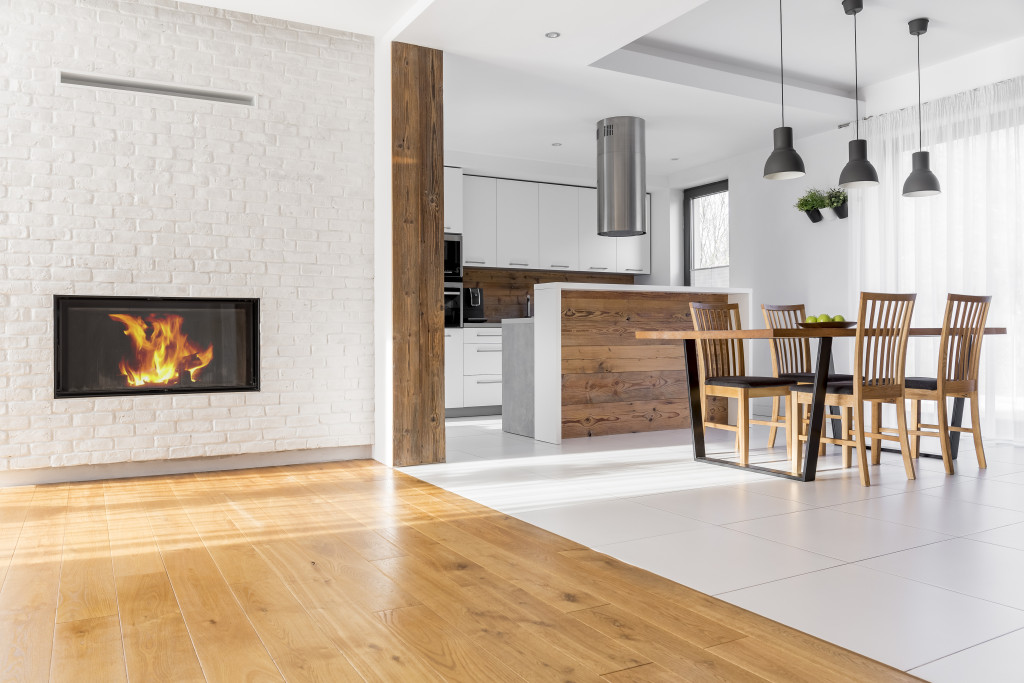- Interior architectural detailing can significantly enhance a home’s aesthetic appeal and value.
- Strategically placed lighting fixtures can highlight and accentuate design elements, adding depth and interest to spaces.
- Wainscoting and paneling are traditional design elements that bring texture and sophistication to walls.
- Custom built-ins provide functionality and visual appeal while integrating seamlessly into a home’s design.
- Artistic ceiling treatments and stair molding can define a space’s style and add elegance to the overall ambiance.
Elevating the architectural detailing of your home’s interior can significantly boost its aesthetic appeal and value. The detailing process requires a keen eye for design and a strategic approach to enhancing each room’s unique features. Here are five expert tips to refine your home’s interior architectural detailing effortlessly and effectively.
1. Strategically Place Lighting Fixtures
Incorporate various lighting fixtures to highlight and enhance your home’s architectural details. Consider investing in recessed lighting, pendant lights, and wall sconces to create depth and interest in spaces. These fixtures can accentuate high ceilings, archways, and niches, casting shadows that bring out the best in your home’s design.
Lighting isn’t just about illumination—it’s a design element that can spotlight the room’s architectural beauty. Experiment with light intensity and positioning to create different moods and effects, emphasizing specific details and creating engaging visual experiences for residents and guests alike.
2. Implement Wainscoting and Paneling

Wainscoting and paneling are traditional design elements that bring texture and depth to your walls. This type of detailing adds a layer of sophistication to any room, from living rooms to dining areas. You can choose from various styles and materials to suit the overall aesthetic of your home.
Integrating these elements requires precision and an understanding of the room’s proportions. When correctly installed, wainscoting and paneling serve as decorative features and protect the walls from damage, ensuring they remain beautiful and intact for a long time.
Here are tips to implement wainscoting and paneling:
Choose the Right Style
There are several styles of wainscoting and paneling, each with its unique aesthetic. Traditional styles like beadboard and picture-frame wainscoting add a classic touch, while board, batten, or shaker paneling lend a more modern feel. Assess your home’s current style and decide on the style that best complements it.
Consider the Height
The height of the wainscoting or paneling significantly impacts the room’s overall look. The rule of thumb is to install the wainscoting at one-third of the wall height for a balanced appearance. However, for a more dramatic effect, consider installing it higher.
Select the Right Material
Wainscoting and paneling come in various materials, including solid wood, MDF (Medium Density Fibreboard), and PVC. Consider the room’s usage and the desired aesthetic when choosing the material. For example, due to its durability, solid wood suits traditional designs and high-traffic areas, while PVC is ideal for damp areas like bathrooms.
Paint or Stain?
Finally, deciding whether to paint or stain your wainscoting or paneling depends on your preference and the chosen material. Paint offers a wide array of colors and finishes, ideal for creating a cohesive look with the rest of the room. Stain, however, showcases the natural beauty of wood grain, perfect for a rustic or traditional aesthetic.
3. Invest in Customized Built-ins
Custom built-ins, such as shelves, cabinets, and benches, provide functionality and visual appeal. These features seamlessly integrate into your home’s design, maximizing space utilization and contributing to a cohesive and organized look. Built-ins can become focal points in a room when designed with attention to detail.
Engage with skilled craftsmen who understand your vision and can create built-ins that align with your home’s architectural style. With careful planning and design, these features can significantly enhance your living spaces’ functionality and aesthetic appeal, providing tailored solutions for your storage and display needs.
4. Select Artistic Ceiling Treatments

Ceilings often serve as blank canvases, offering ample opportunities for creative architectural detailing. Invest in crown molding, medallions, or coffered ceilings to bring elegance and character to your rooms. These features can define the space’s style and atmosphere, creating visual interest above eye level.
When selecting ceiling treatments, consider the room’s size and height to ensure the detailing is proportional and appropriate. Proper installation is crucial to achieving a polished and harmonious look, as sloppy work can detract from the beauty of these intricate details.
5. Enhance Staircases with Molding
Staircases are often central elements in a home, providing dramatic and engaging architectural detailing opportunities. By incorporating stair molding, you can define and enhance the staircase’s structure, bringing attention to its form and creating a more refined and sophisticated appearance.
For instance, stair molding can serve as an elegant connector between the steps and the wall, creating a visual frame that outlines and accentuates the staircase’s presence. Whether you choose a simple or elaborate design, stair molding adds a layer of intricacy and elegance, contributing positively to the overall ambiance of your home.
In Closing
Enhancing your home’s interior architectural detailing requires a thoughtful approach and a commitment to quality and precision.
By strategically placing lighting, implementing wainscoting and paneling, investing in customized built-ins, selecting artistic ceiling treatments, and enhancing staircases with molding, you can create a space that reflects attention to detail, sophistication, and a deep understanding of architectural beauty and functionality.
Each element, carefully chosen and installed, contributes to a harmonious and visually pleasing environment that speaks of your taste and appreciation for exquisite design.

